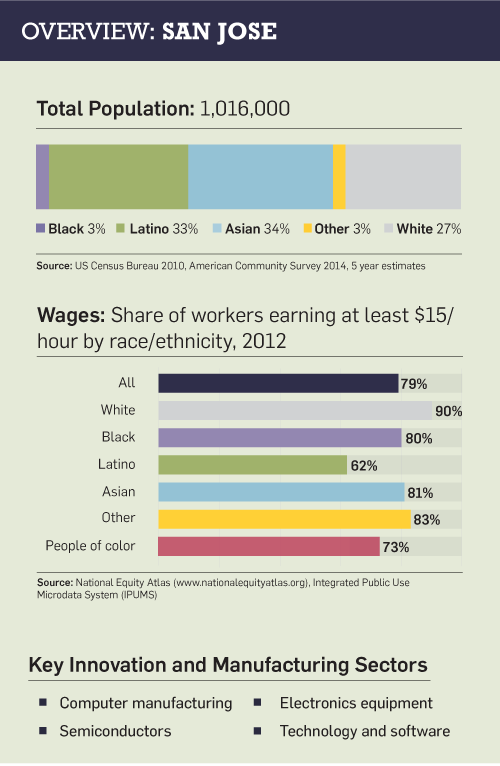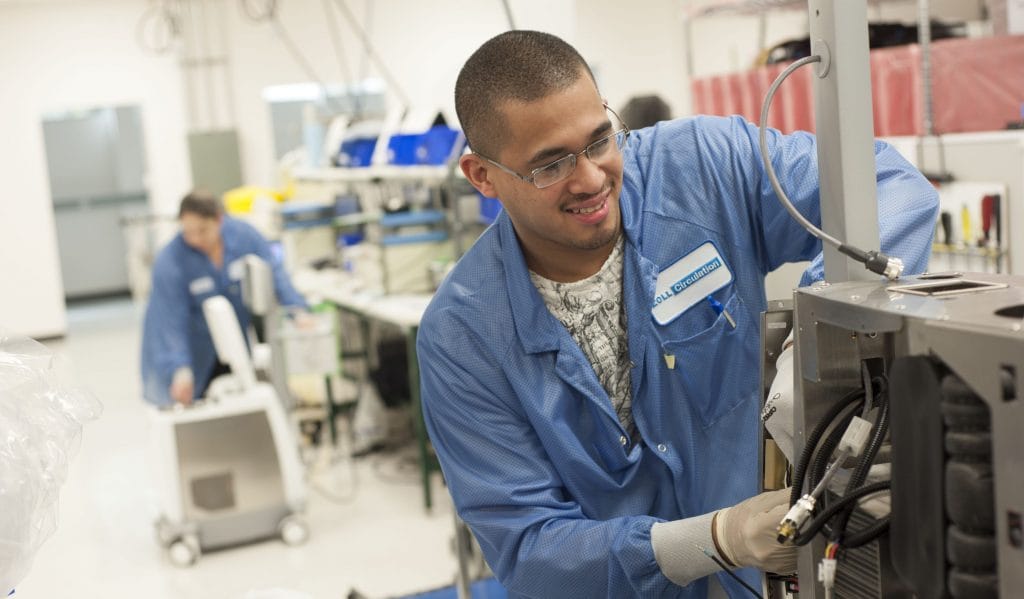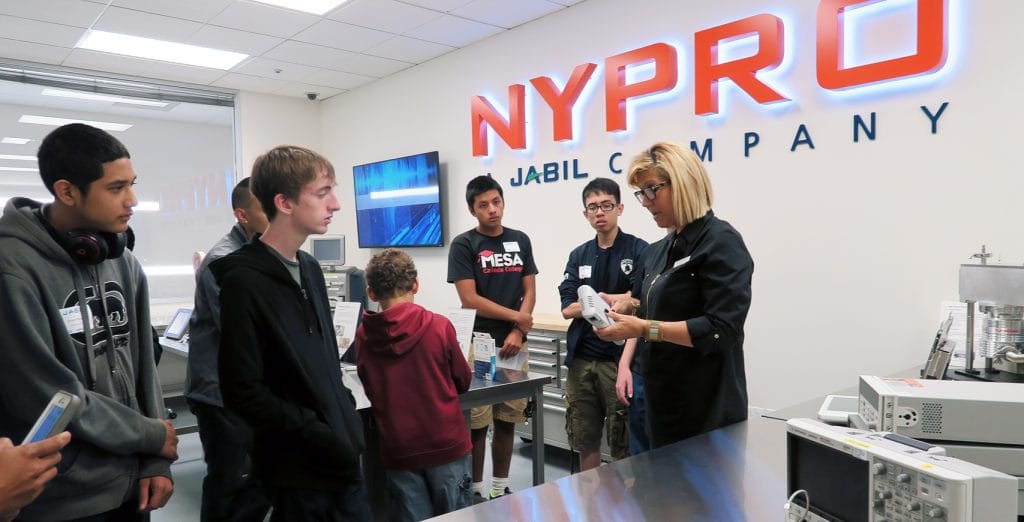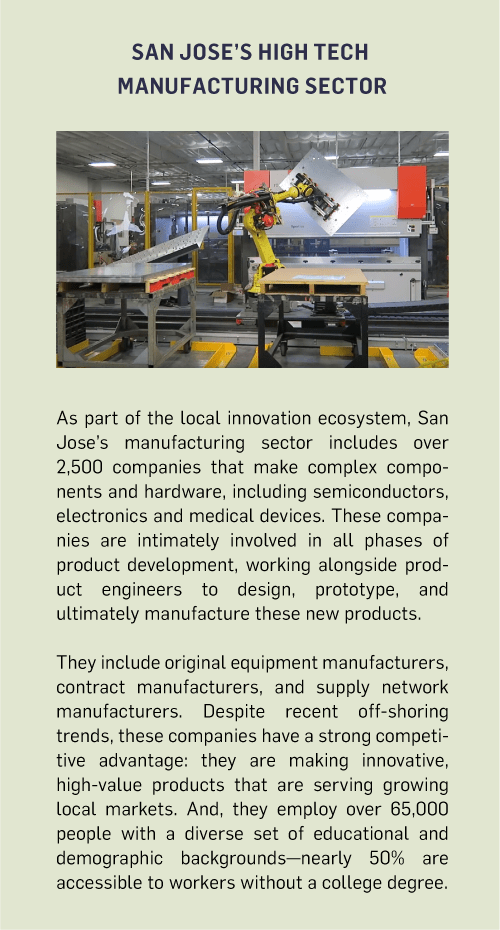San Jose City Snapshot
San Jose has been a bastion of high-tech manufacturing since the emergence of Silicon Valley, but the future of this industry is far from assured. To strengthen the sector and open up opportunities for a new generation of diverse workers, the City is using a silo-busting strategy that combines business support, workforce development, and land use preservation.

Silicon Valley’s Inequality Problem – and How Manufacturing Can Help Solve It
Income inequality in Silicon Valley has been making national headlines recently as employment growth and wages in the tech sector have soared to new heights, while wages for other workers have largely stagnated.1 Recognizing this bifurcation in the region’s economy, the City of San Jose has been focused on manufacturing as a key pillar of its economic strategy. San Jose’s Office of Economic Development (OED) views the sector as a critical source of entry-level and middle-skill, middle-wage jobs that benefit San Jose’s lower income residents from communities of color.
Although the region’s manufacturing sector is heavily focused on high-tech research and development, over 40,000 or one in four manufacturing jobs in the San Jose metro area are production-related roles such as assemblers, machinists and welders. These production occupations have median wages of $18 per hour, and typically require a high school diploma or equivalent with moderate on-the-job training.2 “There are likely to be a good number of job openings in manufacturing in coming years, particularly jobs that don’t require a college degree and have good opportunities for advancement, especially as the existing workforce retires,” explains Michelle Thong, Business Development Officer for the City of San Jose.
“Although there is a lot of robust manufacturing activity in San Jose, much of it is unknown to many of our residents of all ages. In particular, youth don’t think about manufacturing as a viable career option.”
MICHELLE THONG, SAN JOSE OFFICE OF ECONOMIC DEVELOPMENT
OED has taken a multi-pronged approach to support manufacturing, including industrial land use preservation, direct outreach to local manufacturers, and multi-stakeholder convenings, such as the Silicon Valley Manufacturing Roundtable. These efforts have helped to keep over 65,000 manufacturing jobs in the city, but there is a need to do more to connect young workers to these jobs. The Equitable Innovation Economies Initiative provided OED and its partners with an opportunity to hone its focus by creating more on-ramps into high-tech and manufacturing careers for young people from low income neighborhoods and communities of color.
Is it a “Skills Gap” or an “Awareness Gap”?
While much literature has been devoted to a national skills gap for manufacturing occupations, OED’s conversations with local businesses and educational institutions suggested that the problem is more of an “awareness gap.” There is a marked disconnect between San Jose’s driving industries and youth awareness around career opportunities. With the “awareness gap” as a target, OED set out to create a pilot program that would increase exposure to high-tech manufacturing careers for low income San Jose youth.

Bestronics works closely with product development teams to engineer, test and manufacture components for the telecommunications, medical and other high-tech industries.
“Although there is a lot of robust manufacturing activity in San Jose, much of it is unknown to many of our residents of all ages,” says Thong. “In particular, youth don’t think about manufacturing as a viable career option.”
A Mayor Invested in Manufacturing – and Workforce Development
In January 2015, Mayor Sam Liccardo took office with a set of policy priorities focused on industrial retention and workforce development. In his March 2015 Budget Message, Mayor Liccardo proposed a bold new initiative called San Jose Works, committing $1 million to create a program that would provide at-risk youth with five weeks of paid work during the summer months. In collaboration with the local Workforce Investment Board partner, work2Future, San Jose Works targeted 18-29 year-olds from neighborhoods with higher than average crime rates and limited job opportunities.
Propelled by its discussions with the EIE pilot group, OED realized a serendipitous opportunity to leverage the San Jose Works program to expose youth to job opportunities in the local manufacturing industry. By layering on top of the San Jose Works program, OED was able to benefit from work2future’s strengths in program administration, youth recruitment, and case management while focusing on its unique contribution: relationships with local businesses.
OED connected work2future with Jabil Circuit, a US-based electronics manufacturing services company and the third-largest contract manufacturer in the world, to participate in the inaugural year of San Jose Works. Work2future worked closely with the manufacturer to engage them in the process and address concerns about taking on youth, including designing a specialized training program for students.
Implementing a High-Tech Internship Program
Jabil’s management team handpicked fourteen interns based on their interest in technology, written communication skills, and capacity to learn and thrive in this work environment. About half of the interns had high school degrees, and half had some college experience. All lived in San Jose neighborhoods that had been identified by the Mayor’s Gang Prevention Task Force as hot spots for gang activity.
Twelve interns were placed in production roles, tasked with assembling intricate equipment like circuit boards. The other two were placed in human resources and warehousing roles, exposing them to the operations side of the company. The interns were paid San Jose’s minimum wage of $10 per hour, working 32-hour weeks.
Many of Jabil’s employees have decades of experience in manufacturing and technology, with tremendous intellectual capital and expertise to share. The program gave these employees a rare opportunity to train and mentor this new generation of vibrant and eager workers.”
VALONNA FOWLER, JABIL CIRCUIT
Jabil provided the interns with insight into the sector, as well as both technical and soft skills: the program included training on communication, workflow management, and an intensive, full-day component identification course, in which employees learn about the materials, equipment, and technical processes of production. At first, they worked closely alongside employee mentors and shadowed full-time employees but were soon able to take on longer term projects of their own.
At the end of the five week program, two students were hired as full-time production employees. For the remainder, the program successfully increased awareness of career paths in manufacturing and passed on solid, transferable skills that would be valued in any workplace.

High school students on a Manufaturing Day tour at Jabil.
In addition to gaining two new full-time employees, the company used the program to develop leadership skills among existing staff. “Many of Jabil’s employees have decades of experience in manufacturing and technology, with tremendous intellectual capital and expertise to share,” reported Valonna Fowler, Learning and Performance Specialist at Jabil. “The program gave these employees a rare opportunity to train and mentor this new generation of vibrant and eager workers.”
The program also enriched employee understanding of the diversity of experiences and backgrounds in San Jose communities, and helped Jabil’s management team to see the value in looking beyond their usual hiring pool, recognizing that qualified candidates are not limited to those who hold specific degrees.
Following on the success of the inaugural year of the program, Jabil and work2future will be partnering again this summer to hire 10 youth interns.
 A Spectrum of Activities
A Spectrum of Activities
The San Jose Works program is just one of several efforts in San Jose to strengthen the manufacturing workforce pipeline. For example, to meet the constantly evolving needs of local manufacturers, work2future partners with local community colleges and universities to provide intensive “cohort trainings” for in-demand skills such as welding, logistics and project management. Over 100 adults have participated in work2future’s manufacturing-related training since fall 2015, with 65 percent gaining employment so far, and the remainder continue to be actively engaged in training and job searches with work2future.
Meanwhile, to deepen the City’s understanding of how best to champion the local manufacturing industry, OED is undertaking a major data collection effort to design and implement a regional manufacturing survey in San Jose, San Francisco, Fremont, and Oakland, in partnership with SFMade, a San Francisco-based non-profit organization that supports manufacturers. Quantifying local manufacturing employment will enable San Jose to better articulate the value of manufacturers to the city’s economy while designing better programs to support the industry.
